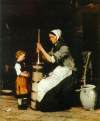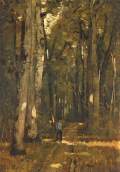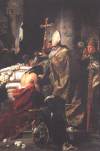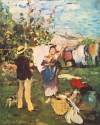Painting and Sculpture in the Second Half of 19th Century

Géza Mészöly (1844-1887) represented landscape painting typical of Hungarian art. He was very strongly related to the careful composition and idyllic atmosphere of Markó and the circle around him but his landscapes represented a much higher artistic level in development and approach. Mészöly, an introverted artist, used to live quietly and had few friends only. He painted mainly pictures of lake shore and river bank landscapes and scenes (especialy of Lake Balaton) which were dominated by sunny peace and eventless happiness. Impressed with changes of nature in the summer, he collected sketches recording his fresh impressions to paint his summer remembrances in his studio in winter months. Whether it is a landscape of the Great Plain or the River Tisza, or the Lake Balaton, beholders have the impression that the picture was made on site: a peculiar kind of convincing originality dominates it (Fishermen's Hut by the Lake Balaton, 1877).
The popular-national school of thought which appeared in genre and historic pictures of Orlay, Jankó and others, reached its peak in the art of Mihály Munkácsy (1844-1900) which amalgamated the very best ambitions of the previous period with national traditions and the lessons of the Munich and Paris schools. It is obviously due to this synthesis that the dramatic power of his pictorial presentation, the beauty of his colours and his characteristic portrayal brought him success in Hungary and abroad. Munkácsy became a celebrated figure of salons and galleries in Paris at a time when pictorial views and artistic approaches had made his outdated. Munkácsy was the first Hungarian painter to represent Hungarian art abroad and, due to his success there, attracted attention to Hungarian art. While he lived abroad, he never disclaimed his being Hungarian. (See details on the art of Munkácsy on separate page.)
Munkácsy as a one of the main representatives of the national tradition had great significance. The forceful contrasts of his colours, the enthusiastic presentation and the suddued romanticism are the characteistics of his paintings which will reappear in the 20th century in the art of the so-called painters of the Great Plain, János Tornyai, József Koszta and Gyula Rudnay.
 László Paál (1846-1879), a landscape painter, was a close friend of Munkácsy. After a trip to Düsseldorf, he ended up in Paris, too, which, in its turn, he left for Barbizon in search of solitude. Paál, faithful to his Barbizon, painted details of nature around him at different times of the day. His pictures are portraits of nature dominated by poetry. In spite of being related to Munkácsy, he was apparently not interested in people, nature meant the sole source of peace and inspiration for him. Figures in the background (Road in the Forest of Fontainebleau, 1875, Depth of the Forest, 1877) are there only to indicate proportions and are not his works at all. Landscape painting which favoured seclusion from the world and gloomy moods prepared a style of 20th century painting where man gave up fighting with nature, instead he surrendered to melancholy.
László Paál (1846-1879), a landscape painter, was a close friend of Munkácsy. After a trip to Düsseldorf, he ended up in Paris, too, which, in its turn, he left for Barbizon in search of solitude. Paál, faithful to his Barbizon, painted details of nature around him at different times of the day. His pictures are portraits of nature dominated by poetry. In spite of being related to Munkácsy, he was apparently not interested in people, nature meant the sole source of peace and inspiration for him. Figures in the background (Road in the Forest of Fontainebleau, 1875, Depth of the Forest, 1877) are there only to indicate proportions and are not his works at all. Landscape painting which favoured seclusion from the world and gloomy moods prepared a style of 20th century painting where man gave up fighting with nature, instead he surrendered to melancholy.
Although Munkácsy tried to do his utmost in order to train pupils, e.g. he supported them with scholarships to go to Paris and learn there, yet he never had a school around him. His art can be best associated with genre pictures based on folk life as represented by pictures painted before the Szolnok art school had been founded. Pál Böhm (1832-1905) painted genre pictures on gypsy romanticism crowded with staffage figures. Later he returned to Munich. In spite of his excellent skills, pictures for art trade became poorer and poorer in quality. Lajos Deák Ébner (1850-1934) adapted much better to conditions in Hungary. He painted bright genre pictures free from problems which fascinate spectators with the spell of informality and apparent simplicity, e.g. Poultry Market, Pottery Market and pictures with similar titles mainly on the market in Szolnok. Precise composition and general impression perhaps too colourful are features indicating massive tension without actually forecasting Munkácsy's deep anguish.
Sándor Bihari (1855-1906) had the same qualities but his choice of subject matter was more favourable. Idyllic optimism dominates his pictures whose composition exceeds those of Deák Ébner both in composition and delicate colours. Before the Magistrate, or Sunday Afternoon (1885) anticipate painters of the Nagybánya school, e.g. the early works of Hollósy. Subject matter carefully selected and indifferent to message behind composition were the keys to his success. Attractive expression represents a major trend of conservative painting at the end of the 19th century.
 Gyula Benczúr (1844-1898) is considered to be the most significant representative of official painting of his age. His great talent suited any subject matter. The first work of Benczúr, who attended the Piloty School in Munich, was Farewell of László Hunyadi (1866), a sentimental example for historic painting accomplished with great artistic skills. Composition, perspective and artistic expression are united in this case. Pompous and theatrical composition, bright colours and the general impression of Baptism of Vajk (1875) make the beholder forget the falseness of the picture which in fact indicates surrender. In many respects, however, it was a typical product of the age when new ways had to be found after the compromise of 1867. His contemporaries were fascinated by the richness of his art recalling that of Rubens and by optimism present in all his works. Benczúr was best at painting portraits which include intimate and fascinating portraits of members of his family, and arrogantly looking official portraits. Many of them show self-confident and solemn faces with excellent character portrayal which make it easy to understand why a master school was established at the Art School for his sake which, in its turn, rivalled with academies abroad.
Gyula Benczúr (1844-1898) is considered to be the most significant representative of official painting of his age. His great talent suited any subject matter. The first work of Benczúr, who attended the Piloty School in Munich, was Farewell of László Hunyadi (1866), a sentimental example for historic painting accomplished with great artistic skills. Composition, perspective and artistic expression are united in this case. Pompous and theatrical composition, bright colours and the general impression of Baptism of Vajk (1875) make the beholder forget the falseness of the picture which in fact indicates surrender. In many respects, however, it was a typical product of the age when new ways had to be found after the compromise of 1867. His contemporaries were fascinated by the richness of his art recalling that of Rubens and by optimism present in all his works. Benczúr was best at painting portraits which include intimate and fascinating portraits of members of his family, and arrogantly looking official portraits. Many of them show self-confident and solemn faces with excellent character portrayal which make it easy to understand why a master school was established at the Art School for his sake which, in its turn, rivalled with academies abroad.
The art of Sándor Liezen-Mayer (1839-1898), a less talented and versatile artist, was overshadowed by that of Benczúr. The choice of subject matter of his most popular picture was, however, very good: Marie Therese is Breastfeeding the Baby of a Beggar Woman, which makes the picture loyal to the empress into a sentimental genre picture. The art of Jenő Gyárfás (1857-1925) was deeper and more promising. His serious ethic issues and subdued expression recall the art of Bertalan Székely. Bier Right shows the influence of the academy, sincerity and qualities are, however, apparent. If his art had been understood, he would have become a master of genre pictures on country life (e.g. Pigsticking). As in the case of Székely, his sketches show a fresher, airier and more artistic approach with which he could have broken down limitations set by academic naturalism.
The painting of Imre Révész (1859-1945) has a peculiar place in Hungarian art. Petőfi and his People, and other pictures related to Petőfi indicate the influence of Munkácsy and his preference for Petőfi. The subject of Panem, his most important work, was taken from a strike of harvesters: its drama, composition and expression criticise society harshly. His later works did not have the daring voice any more, his art became fainter.
It is not surprising in the diversity of styles, promising first steps and unsuccessful attempts that artists following individual paths appeared who did not belong to any of the main streams, who were never really appreciated and whose life-works, unfortunately, remained incomplete, e.g. Pál Szinyei Merse and László Mednyánszky, two artists strongly differing from one another in approach.
 Pál Szinyei Merse (1845-1920) of a gentry family in the Highlands was an admirer of nature, an artist radiating optimism who lived together with nature. Szinyei was not a martial spirit and suffered much because of individual and social conflicts. His early pictures (Drying Clothes, The Swing) were followed by Picnic in May (1873), his major work, which was accepted with aversion because of its bright colours, peculiar perspective and informal composition without poses. It was Keleti whose critique was particularly hard on him. Szinyei who was deeply hurt by not being understood retired and gave up painting. Bright optimism and apparent ease which made Picnic in May so fascinating were no longer present in Lady in Violet (1874), a portrait of his wife. Picnic in May brought him success only much later, at the Millennial Exhibition in 1896 where it was favourably accepted by artists of the art school of Nagybánya attracting attention to pictures of Szinyei painted during years of seclusion. Peaceful nature, delicate composition and colours reflect little of the gracefulness, airiness, and light brushwork of the early years. This is why Szinyei was often compared with impressionist artists although he never saw their works. After Szinyei had been rediscovered, he became first a teacher, then the director of the Art School but he never attained the peak of his early period again.
Pál Szinyei Merse (1845-1920) of a gentry family in the Highlands was an admirer of nature, an artist radiating optimism who lived together with nature. Szinyei was not a martial spirit and suffered much because of individual and social conflicts. His early pictures (Drying Clothes, The Swing) were followed by Picnic in May (1873), his major work, which was accepted with aversion because of its bright colours, peculiar perspective and informal composition without poses. It was Keleti whose critique was particularly hard on him. Szinyei who was deeply hurt by not being understood retired and gave up painting. Bright optimism and apparent ease which made Picnic in May so fascinating were no longer present in Lady in Violet (1874), a portrait of his wife. Picnic in May brought him success only much later, at the Millennial Exhibition in 1896 where it was favourably accepted by artists of the art school of Nagybánya attracting attention to pictures of Szinyei painted during years of seclusion. Peaceful nature, delicate composition and colours reflect little of the gracefulness, airiness, and light brushwork of the early years. This is why Szinyei was often compared with impressionist artists although he never saw their works. After Szinyei had been rediscovered, he became first a teacher, then the director of the Art School but he never attained the peak of his early period again.
László Mednyászky (1852-1919), a lonesome artist, came of a gentry family in the Highlands. He never learnt what livelihood problems meant. Serious questions of life were the main feature of his art. Restless all his life, he travelled extensively. He was interested in landscape which in his pictures appeared in the form of gloomy caves and mud covered roads, moorland and menacing woods at sunset or sunrise. He was never attracted by brightness and happiness. The same applies to his pictures involving figures from folk life, tramps, soldiers or faces only. They were filled with freshness and vividness rarely seen at his age. A feeling of responsibility to face difficulties urged him to work as a war-reporter at the front in World War I where - among others - the picture In Serbia (1916) was painted. In the deserted battle field covered by snow, dead and wounded soldiers can be seen. Neither sentimental readiness to sacrifice of the reform age, nor loud and victorious patriotism after the compromise of 1867 is present. Suffering and death, trials and tribulations afflicting the poor and the defenceless face us which makes Mednyánszky express the message of the turn of the century.
He was interested in landscape which in his pictures appeared in the form of gloomy caves and mud covered roads, moorland and menacing woods at sunset or sunrise. He was never attracted by brightness and happiness. The same applies to his pictures involving figures from folk life, tramps, soldiers or faces only. They were filled with freshness and vividness rarely seen at his age. A feeling of responsibility to face difficulties urged him to work as a war-reporter at the front in World War I where - among others - the picture In Serbia (1916) was painted. In the deserted battle field covered by snow, dead and wounded soldiers can be seen. Neither sentimental readiness to sacrifice of the reform age, nor loud and victorious patriotism after the compromise of 1867 is present. Suffering and death, trials and tribulations afflicting the poor and the defenceless face us which makes Mednyánszky express the message of the turn of the century.
By the late 19th century the palette had become extremely rich both in styles and subject matters. Patriotic sentimentality of the age marked by 1848 which was turning more and more naive existed side by side with the apparently false pathos and naturalism of the Munich Academy which, however, indicated individual inspiration. These new events anticipated changes encouraging streams and movements in the 20th century which led to the establishment of new groups and art schools.
The artists' colony at Nagybánya founded by Hollósy in 1896 was one of the earliest and the most important of its kind mushrooming in the 20th century. Great artistic care was characteristic of painters excellent mainly at landscapes and compositions with figures of whom Károly Ferenczy was the most significant. From genre pictures on folk life to large size historic pictures, Árpád Feszty (1856-1914) deliberately chose to apply the panorama. The Conquest (The Entrance of the Hungarians), a panorama picture, is a good example. Petőfi among Soldiers, a picture by Pál Vágó (1854-1928) represented this approach, while Ottó Baditz (1849-1936) was sensitive to new social problems. Infanticide, a picture by him, appeared to be a promising beginning of critical realism which went over to bright genre pictures on folk life. Early works of Simon Hollósy (1857-1916), Oszkár Glatz (1872-1958) and István Csók (1865-1961) included such pictures, their art, however, belong to the 20th century. József Rippl-Rónai (1861-1921) worked under Munkácsy but the distance between them grew with time. The early period of his art showed characteristic features of Art Nouveau. (The art of Rippl-Rónai is discussed in the next period.)
Bertalan Karlovszky (1858-1936), a follower of Munkácsy and Benczúr, was the most typical representative of academism with his careful but heartless portraits. Fülöp László (1869-1938), a contemporary of his, who painted elegant, effortless and excellent pictures became a master of impressive social portraits. He was a welcome artist in the courts of all sovereigns of his time eclipsing his contemporaries in Hungary.
 László Paál (1846-1879), a landscape painter, was a close friend of Munkácsy. After a trip to Düsseldorf, he ended up in Paris, too, which, in its turn, he left for Barbizon in search of solitude. Paál, faithful to his Barbizon, painted details of nature around him at different times of the day. His pictures are portraits of nature dominated by poetry. In spite of being related to Munkácsy, he was apparently not interested in people, nature meant the sole source of peace and inspiration for him. Figures in the background (Road in the Forest of Fontainebleau, 1875, Depth of the Forest, 1877) are there only to indicate proportions and are not his works at all. Landscape painting which favoured seclusion from the world and gloomy moods prepared a style of 20th century painting where man gave up fighting with nature, instead he surrendered to melancholy.
László Paál (1846-1879), a landscape painter, was a close friend of Munkácsy. After a trip to Düsseldorf, he ended up in Paris, too, which, in its turn, he left for Barbizon in search of solitude. Paál, faithful to his Barbizon, painted details of nature around him at different times of the day. His pictures are portraits of nature dominated by poetry. In spite of being related to Munkácsy, he was apparently not interested in people, nature meant the sole source of peace and inspiration for him. Figures in the background (Road in the Forest of Fontainebleau, 1875, Depth of the Forest, 1877) are there only to indicate proportions and are not his works at all. Landscape painting which favoured seclusion from the world and gloomy moods prepared a style of 20th century painting where man gave up fighting with nature, instead he surrendered to melancholy.



 He was interested in landscape which in his pictures appeared in the form of gloomy caves and mud covered roads, moorland and menacing woods at sunset or sunrise. He was never attracted by brightness and happiness. The same applies to his pictures involving figures from folk life,
He was interested in landscape which in his pictures appeared in the form of gloomy caves and mud covered roads, moorland and menacing woods at sunset or sunrise. He was never attracted by brightness and happiness. The same applies to his pictures involving figures from folk life,